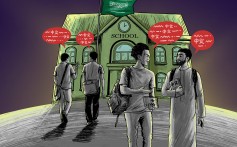THE NEW IMPERIALISM
From railways to 5G: why China is plugging into the Digital Silk RoadBelt and road infrastructure deals have taken a back seat as countries struggle with debt and their priorities shift, analysts say
Digital projects are ‘taking centre stage’ as Beijing tries to cement its status as a global tech leader and keep the initiative relevant
Dewey Sim
15 Oct, 2023
China will hold its third Belt and Road Forum on Tuesday and Wednesday to celebrate the 10-year anniversary of this mammoth investment initiative amid doubts of its benefits and sustainability. In the first of a three-part series, Dewey Sim looks at how the Digital Silk Road has emerged as a driving force to keep the initiative appealing and help promote China as a global technology leader.
At the first Belt and Road Forum for International Cooperation in 2017, Chinese President Xi Jinping touted the global infrastructure-building plan as “a project of the century”.
He recounted the story of the Silk Road, telling world leaders in Beijing that “our ancestors, navigating rough seas, created sea routes linking the East and West”.
From a railway in Indonesia to a port in Pakistan, the Chinese leader said the Belt and Road Initiative had brought “enhanced infrastructure connectivity” to the world.
“We should promote land, maritime, air and cyberspace connectivity, concentrate our efforts on key passageways, cities and projects and connect networks of highways, railways and seaports,” he said.
Six years on, analysts say the huge infrastructure deals Beijing previously championed appear to have taken a back seat as countries struggle with mounting debt and as their priorities shift.
China defends Africa investments as it gears up for belt and road forum
14 Oct 2023

Instead, projects under what China calls the Digital Silk Road have emerged as a driving force of the initiative, now in its 10th year.
At the forum in 2017, Xi had listed the digital economy as a “frontier area” of cooperation. Analysts say China’s digital push is part of efforts to cement its status as a global technology leader while keeping the belt and road plan appealing as it tries to expand its influence around the world.
Soft power
China launched the Digital Silk Road in 2015 as the technological arm of the Belt and Road Initiative aimed at boosting digital connectivity.
While it remains loosely defined, analysts agree that it broadly covers network infrastructure such as 5G, e-commerce and the digital economy, as well as urban planning.
Lim Tai Wei, an associate professor at the Singapore University of Social Sciences, said Digital Silk Road projects had grown in importance in recent years because some emerging economies had matured beyond basic infrastructure needs.
“[Countries] are ready to kick-start their own Industrial Revolution 4.0 and are now requesting that Beijing share those technologies with them,” he said.
Last year, a report by the official People’s Daily said countries along the belt and road plan’s trade routes had “weak digital infrastructure and low access rates to the internet” and that China was helping them in those areas.
Yu Hong, a senior research fellow at the National University of Singapore’s East Asian Institute, said developing countries increasingly saw the value digital technologies could bring to economic growth.
He said that while infrastructure projects would still be the mainstay for some countries such as Cambodia or Laos – where physical infrastructure remained weak – others have sought to tap into China’s tech capabilities.
One example was African countries. In August, Wu Peng, director general of the Chinese foreign ministry’s Department of African Affairs, said African nations had asked Beijing to consider a shift away from building infrastructure.
China’s Belt and Road, 10 years on
Beijing’s belt and road projects in Africa have mostly focused on critical infrastructure such as roads, railways and ports.
In Southeast Asia, Malaysian Prime Minister Anwar Ibrahim told Xi in April that his country would work with China to expand cooperation in the digital economy.
Domestic reasons have also played a part in raising the profile of the Digital Silk Road.
Lim, from the Singapore University of Social Sciences, said China’s technological capabilities had grown rapidly in the past decade and it was now a “peer competitor” with the United States.
Exporting this tech meant China could build its own circle of friends “for its own interests” as the West increasingly looks to de-risk from China and cut off Chinese technologies, he said. Digital projects would allow China to set its own tech standards and it would be a “win-win situation” when other countries adopted them.
Lim said Digital Silk Road projects were “taking centre stage, and unlike basic infrastructure they require less capital-intensive and long-term commitments”.
“Technology is a form of soft power as it demonstrates China’s tech leadership that can attract countries to follow their standards without China compelling them to do so. That is a classic definition of soft power, in this case tech soft power.”
Mandarin learning boom as China extends its soft power in Middle East
18 Sep 2023

Alvin Camba, assistant professor at the Josef Korbel School of International Studies at the University of Denver, said digital projects had gained significance as China involved its major tech firms, from Huawei to Tencent.
Ventures under the initiative could help China increase its commercial gains, he said, adding that digital projects “seem to be the pillar of the Belt and Road Initiative which has the most momentum today”.
Yu from the East Asian Institute said China intended to use the Digital Silk Road “to cement its position as a leading international technology power through increasing the digital access among the urban and rural population of developing countries”.
Chim Lee, a China analyst at the Economist Intelligence Unit, noted that China’s developmental finance and overseas direct investments had slowed in the past few years.
He said risk tolerance had declined among many Chinese investors as the government increasingly emphasised the “rationalisation” of overseas investments.
The Chinese president in 2021 urged companies to avoid “dangerous” places and to prioritise “small and beautiful” projects when he set out plans to move the belt and road scheme forward.
“In this context, the average size of China’s overseas lending commitment has declined. Digital infrastructure projects thus become more viable compared to railways and roads given that they tend to be smaller in size,” Lee said.
According to a report by the Green Finance and Development Centre, a think tank at Fudan University in Shanghai, the average deal size in the first half of this year was US$392 million – 48 per cent smaller than in 2018 when investments peaked. The average investment in the first half of this year was about 36 per cent lower than last year.
The report, published in August, stated that the deal size of construction projects was “the lowest” since the Belt and Road Initiative was launched.
Lee said he expected the overseas footprint of China’s digital economy actors to continue expanding as the country’s income and tech capabilities advance and as its domestic market matures.
‘Adaptive’ by design
According to the Cyberspace Administration of China, the country’s internet regulator, 17 countries have signed agreements specific to the Digital Silk Road. Analysts expect that number to grow, even as Western nations flag security concerns over Chinese technologies.
China hits back at US in chip war with probe into Micron’s products
31 Mar 2023

Camba from the University of Denver said countries with little or no conflict with China and those with few questions about espionage would likely gravitate towards its digital initiatives.
That includes countries in the Global South, which broadly refers to developing or underdeveloped economies in Africa, Asia and Latin America. Camba said those nations “by and large … do not buy how the West portrays China”.
Yu similarly said the Global South would be the “priority” for China’s Digital Silk Road push, noting that investment from Beijing had been welcomed despite Western pressure.
“China will use most of its diplomatic resources and energy on the Global South. That’s certainly going to be the key for the Belt and Road Initiative moving forward,” he said.
Russia, Egypt and Saudi Arabia were likely at the top of the list of countries China wanted to expand into, he added.
Yu said countries that have been hotspots for belt and road investments – especially those in Southeast Asia and Central Asia – would be receptive to Chinese digital projects.
Chinese tech firms could offer them products and technologies that are competitive in cost and quality – factors that matter to developing economies.
Analysts say China’s shift away from bigger infrastructure projects is a continual effort to satisfy the needs of other countries in a bid to keep its belt and road scheme relevant.
Besides the digital push, Lim from the Singapore University of Social Sciences said Beijing had also transitioned from basic infrastructure projects to helping countries with industrialisation.
There has also been a greater emphasis on cleaner energy sources like small nuclear reactors to reduce the carbon footprints of participating countries.
Camba said the belt and road plan was “very adaptive” by design. He cited the “political priority” given to the initiative by Beijing, meaning it has been allocated more political and economic resources.
According to Yu, China’s aim was for the initiative to be “flexible and inclusive” so it could cater to countries in different regions. He noted that its success depended on how receptive other countries were to the plan, and that keeping it viable was important for China’s geostrategic ambitions.
Camba said it was important for the initiative to evolve. “China’s own influence depends by and large through these projects,” he said. “Outside political and economic power, China’s influence wanes.”

Dewey Sim is a reporter for the China desk covering Beijing's foreign policy. He was previously writing about Singapore and Southeast Asia for the Post's Asia desk. A Singapore native, Dewey joined the Post in 2019 and is a graduate of the Wee Kim Wee School of Communication and Information.

No comments:
Post a Comment